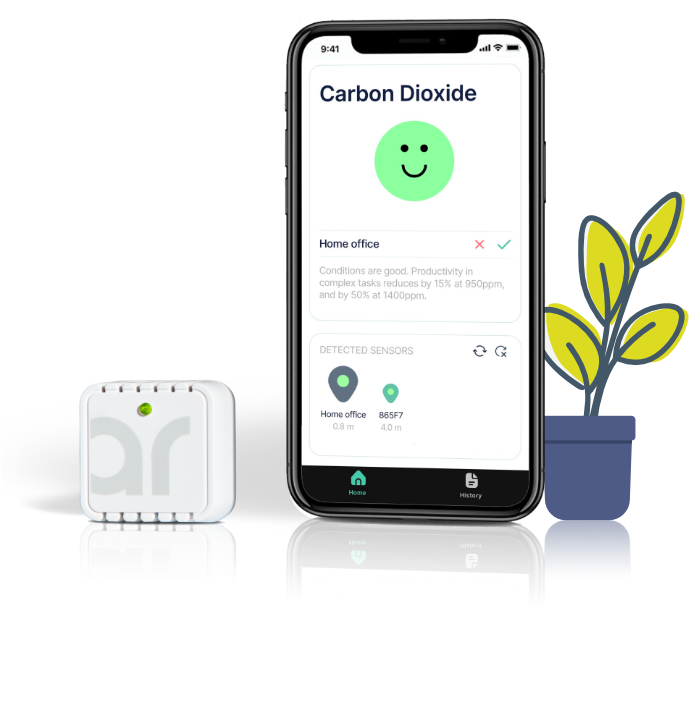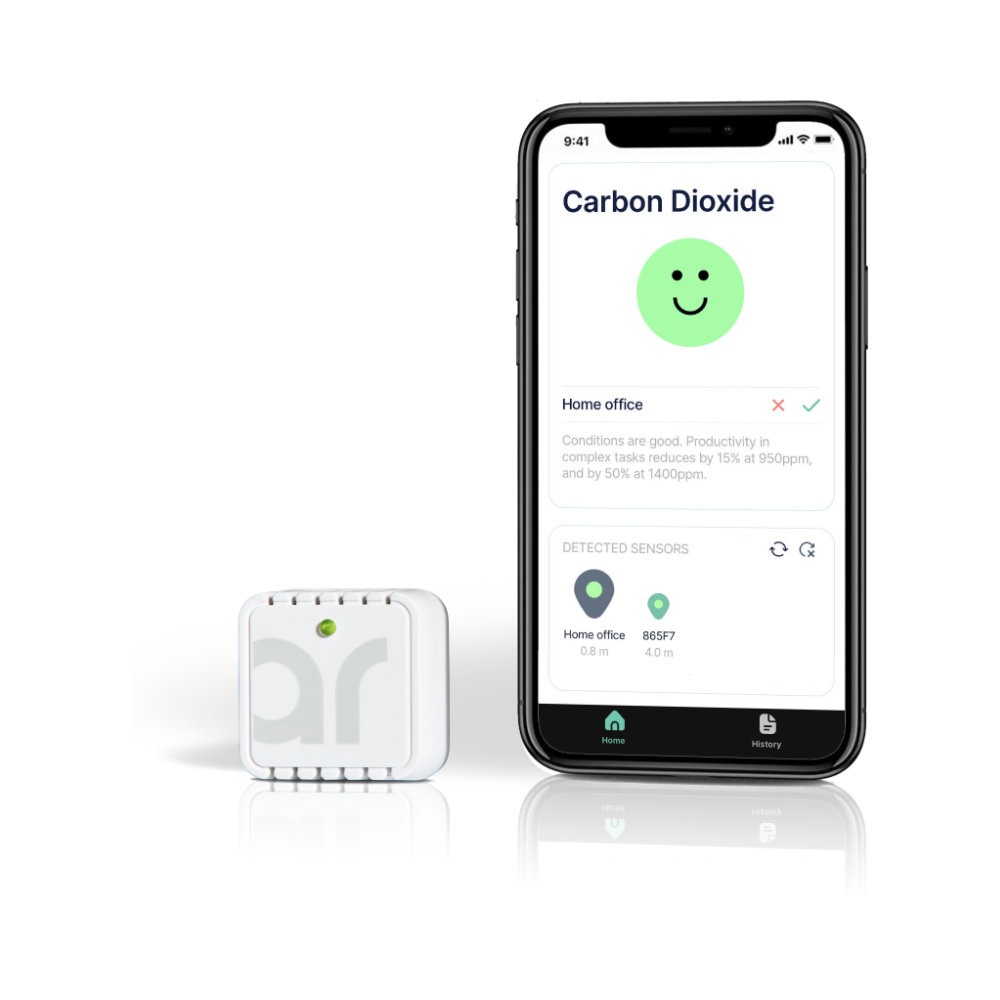Table of Contents

How does a CO2 meter work?
CO2 meters are instruments designed to determine the level of carbon dioxide in the ambient air. In recent years, they have become increasingly popular, especially in offices, schools and other public buildings, as they help to raise awareness of indoor air quality. But how exactly do these devices work?
Most CO2 meters use infrared absorption spectroscopy (NDIR technology) to detect carbon dioxide. CO2 molecules absorb infrared light of a specific wavelength. A CO2 measuring device sends a beam of infrared light through a sample of the air to be measured. A sensor on the other side measures the amount of light that passes through. The more CO2 present in the sample, the more light is absorbed, and the device can provide an accurate measurement of the CO2 content in the air.
Another aspect that must be taken into account for the accurate measurement of CO2 in the air is temperature. As the density of gases varies with temperature, many CO2 meters also need to measure the temperature of the ambient air to provide accurate results. Some more advanced models can also measure humidity, as this can also affect the CO2 content in the air.
Using a CO2 meter is quite simple. Most devices are portable and can be placed in the room where you want to measure the CO2 level. Many devices also offer continuous monitoring, where the data is automatically updated at regular intervals. These continuous readings can be particularly useful for tracking trends over time or determining whether ventilation measures are effective.
Not all CO2 meters are the same. There are differences in terms of measurement accuracy, measurement range and additional functions. Some devices, such as the so-called “CO2 traffic lights”, offer visual indicators of CO2 levels ranging from green (good air quality) to red (poor air quality), which allows for an intuitive understanding of the current air quality.
In conclusion, a CO 2 meter is powerful instruments that can provide us with valuable information about the quality of the air in our indoor spaces. They help us to create a safe and healthy environment by alerting us to high CO2 concentrations and helping us to ventilate in time or take other measures to improve air quality.

What does “ppm” mean in CO2 measurements?
“Ppm” stands for “parts per million” and indicates how many molecules of CO2 are present in one million air molecules. For example, a value of 400 ppm means that there are 400 molecules of CO2 in one million air molecules.

Why CO2 measuring devices are important
Carbon dioxide (CO2) is a natural gas that is released when humans and animals breathe during natural process. Elevated CO2 levels indoors can lead to headaches, fatigue and poor concentration. A CO2 meter measures the concentration of this gas in indoor air, often in ppm (parts per million). As soon as the CO2 level reaches a critical point, the devices can trigger an alarm or visual (red light) notification.Fresh air, fresh ideas!
Fresh air not only boosts your mood, but also improves your health and productivity.
With Sensar, you can monitor the CO2 content in your room and ensure that conditions are always optimal.

What to look out for when buying a CO2 meter
There are some important factors to consider when buying a CO2 meter. The measuring accuracy is of course crucial. Another important criterion is the measuring range. As a rule, a range of 0 to 5000 ppm is sufficient for homes and offices. Devices that also display other data such as temperature and humidity can be particularly useful.
The power supply aspect and the ability to store data or transfer it to other devices can also be decisive, depending on the application. The power supply that can be charged through USB cable is particularly attractive, because it gives more flexibility, minimise energy usage and avoid buying environmental unfriendly equipment, such as batteries. Another point is ease of use. A good CO2 meter should be easy to use and read.
What is carbon dioxide and how is it measured?
Carbon dioxide, often abbreviated as CO 2, is a colourless and odourless gas that occurs naturally in our atmosphere. It is a by-product of numerous processes, including human and animal respiration, the burning of fossil fuels and many industrial activities.
Carbon dioxide plays a key role in the natural greenhouse effect, which is why its concentration in the atmosphere is of great importance, both from an environmental and health perspective.
But how exactly do you measure CO2? The measurement of carbon dioxide indoors has become increasingly important in recent years, particularly in the monitoring of air quality in buildings. This is where CO 2 measuring devices, sometimes referred to as “co 2 meters”, come into play. They provide a quick and accurate way to monitor carbon dioxide levels in the air.
Most of these devices use infrared absorption spectroscopy, a method in which CO2 molecules absorb infrared light. A CO 2 meter sends a beam of this light through an air sample and measures how much of it is absorbed by the CO2 molecules. The higher the carbon dioxide concentration, the more light is absorbed.
The CO2 traffic lights that display the CO2 content in the air. These traffic lights use LED indicators to visually display the level: Green indicates a safe level, while red indicates elevated CO2 levels that may require ventilating the room.
Another method of measuring CO2 is the use of chemical indicators. This uses a material that changes colour depending on how much carbon dioxide is present. This method is less commonly used than infrared measurements, but can be useful in certain applications.
In conclusion, carbon dioxide is an important gas whose presence and concentration in our environment must be continuously monitored. Whether for health reasons, to control indoor climate systems or to monitor carbon dioxide levels in the earth’s atmosphere, accurate measurement of CO2 is crucial.
Thanks to modern technologies, including the many varieties of CO2 measurement devices, we can now take precise and efficient measurements, ensuring a better and safer environment.
How high can the CO2 concentration in a room be?
The CO2 concentration in a room is an indicator of the indoor air quality. While carbon dioxide (CO2) is not toxic in itself, an increased CO2 content in the air can displace the oxygen content and lead to a range of health complaints. Such symptoms can range from headaches and fatigue to poor concentration. It is therefore important to monitor indoor CO2 levels and ensure that they remain within safe limits.
It is generally assumed that a CO 2 concentration of around 400 ppm (parts per million) corresponds to the average outdoor level. However, in indoor spaces, especially those that are poorly ventilated or where there are many people, this level can rise quickly. A value of 1,000 ppm is often regarded as the upper limit for acceptable indoor air quality. If the CO2 level exceeds this point, it is likely that the air quality will need to be improved, often simply by ventilating the room.
Many CO2 meters and CO2 traffic lights are designed to alert the user when the CO2 level exceeds a certain threshold. The traffic light display – green, yellow and red – serves as a visual indicator of the CO2 concentration. At green, the CO2 concentration is in the safe range, at yellow you should be careful and at red it is urgently advisable to take action, such as ventilating the room. For example, Sensar has following functions:
Green: CO2 is below 950ppm. These are optimal conditions for productivity and represent the lowest viral risk factor.
Amber: CO2 is from 950 to 1400ppm. Productivity may be reduced by up to 15% at 950ppm and 50% at 1400ppm; viral transmission risk is increased.
Red: CO2 is above 1400ppm. As CO2 levels increase productivity will keep decreasing and viral transmission risk will be high. Action should be taken to increase fresh air flow, for example by opening windows, doors, or increasing fresh air ventilation.
In conclusion, monitoring CO2 levels plays a crucial role in ensuring a healthy indoor environment. While an increase in CO2 levels can be a sign of poor air circulation, timely intervention, such as opening windows or using ventilation systems, can help reduce the CO2 concentration and ensure a safe and comfortable environment for all.
How important is consistent ventilation?
Consistent ventilation plays a crucial role in the health and well-being of the people in a room. Adequate air exchange helps to reduce the accumulation of CO2, potentially harmful particles and other pollutants.
People in a room with a high concentration of CO2 can experience symptoms such as headaches, dizziness or concentration problems. Ventilation not only reduces CO2 levels, but also helps to reduce the risk of respiratory illnesses and allergic reactions.
Despite the obvious health benefits of ventilation, there are also energy aspects to consider. In colder months, regularly opening windows can lead to heat loss. It is therefore important to coordinate ventilation with temperature control in order to ensure a comfortable indoor climate and energy efficiency at the same time. CO2 meters and CO2 traffic lights can help determine the best time to ventilate by indicating when the carbon dioxide concentration reaches a critical level, and it is also important to note that CO2 is only one aspect of air quality. Other factors such as temperature, humidity and the presence of other pollutants also play a role. It therefore makes sense to invest in a good CO2 measuring device that can also measure other parameters.
Prevention of mold growth
Another benefit of consistent ventilation is the prevention of a mold growth in buildings. Mold often develops in humid environments, and good ventilation helps to regulate humidity. In combination with measuring humidity, CO2 meters can serve a dual purpose, monitoring both CO2 concentration and humidity to ensure an optimal indoor climate.
In conclusion, consistent ventilation is crucial not only for health but also for the overall quality of the indoor environment. A well-ventilated space can improve overall well-being, increase productivity and even help to reduce energy costs. In this day and age, when we spend much of our lives indoors, it is even more important that the air we breathe is clean and fresh.
Smart CO2 measuring devices: data straight to your cell phone
Technology has made enormous progress in recent years, and this is clearly evident in the world of CO2 measuring devices. In addition to conventional devices that simply display CO2 levels, there are now “smart” CO2 meters that are connected directly to our smartphones or other smart devices.
How smart CO2 meters work? A smart CO2 meter usually uses CO 2 sensors to measure the carbon dioxide concentration in a room or building. What sets it apart from conventional meters, however, is its ability to transmit this data wirelessly to a smartphone, tablet or even a smart home system.
Using an associated app, users can then monitor the current CO2 level, humidity, temperature and any other relevant data in real time. Some apps even offer the option of setting up notifications or alarms if the CO2 level exceeds a certain threshold, so that immediate ventilation or other measures can be taken.
Integration into modern building technology
As technology advances, CO2 measuring devices are becoming increasingly intelligent. Many devices, especially smart CO2 measuring devices, can be integrated directly into a company’s smart home or building automation system.
This enables automatic control of ventilation systems based on the current CO2 values. A modern technology can be used to download data for later analysis or to update the measuring device.
An important aspect when implementing CO2 measuring devices in companies is measurement accuracy. It is important to ensure that the devices are regularly calibrated and provide accurate readings. Attention should also be paid to an energy-efficient power supply, especially if many devices are installed in a large building. Another point is the placement of the measuring device. It should be installed in a place that allows a representative measurement of the CO2 concentration indoors.
For example, this kind of technology for modern buildings is provided by LightFi Ltd who is manufacture of the Sensar, Sahara and Hoth
Can I also connect my CO2 meter to other smart devices in my home?
Yes, some modern CO2 measuring devices offer smart home integration. For example, they can be connected to other devices via Wi-Fi or Bluetooth to control automatic ventilation systems or send notifications to your cell phone.
How accurate are CO2 meters?
Accuracy varies depending on the device and manufacturer. It is important to pay attention to the stated measurement accuracy and range when purchasing.
LightFi Ltd, who is manufacture of Sensar, Hoth and Sahara are offering devices with high standard accuracy that, comply with BREEM In-Use certification. For further details please see pages
Technical specification Sensar
Technical specification Sahara
Technical specification Hoth
What does a CO2 traffic light mean?
A CO2 traffic light indicates the current CO2 concentration in a room using colours: green stands for good, yellow for medium and red for poor air quality. It is an intuitive method to quickly assess the indoor air quality.
Fresh air, fresh ideas!
Fresh air not only boosts your mood, but also improves your health and productivity.
With Sensar, you can monitor the CO2 content in your room and ensure that conditions are always optimal.

